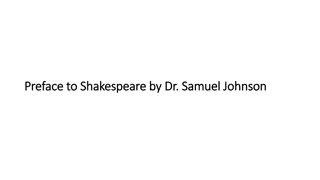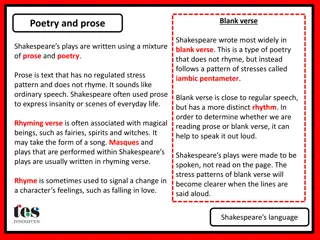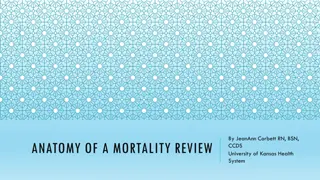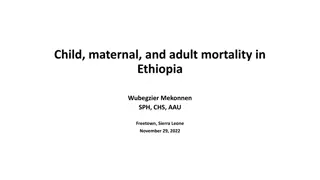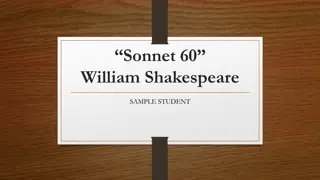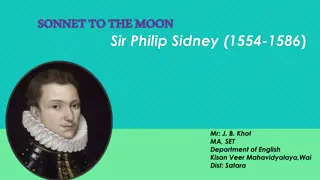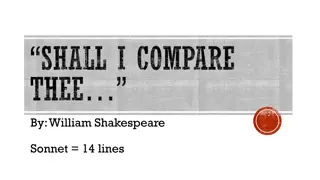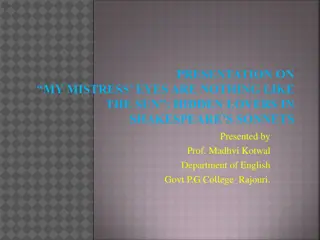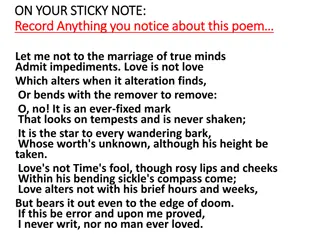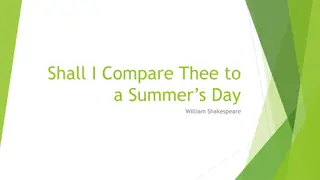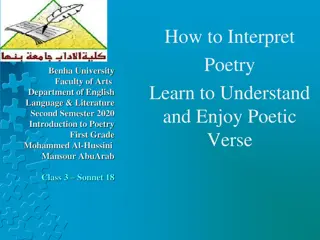Analysis of Shakespeare's Sonnet 60: Time and Mortality
Shakespeare's Sonnet 60 delves into the universal themes of time and mortality through vivid imagery and poignant reflections. The poem uses concrete images like waves and minutes to symbolize time's relentless progression and its impact on human life. As the sonnet progresses, the poet contemplates the inevitability of aging and death, highlighting the cyclical nature of life and the transient nature of beauty. Through elegant language and rich symbolism, Sonnet 60 encapsulates the profound anxieties and contemplations surrounding the passage of time.
Download Presentation

Please find below an Image/Link to download the presentation.
The content on the website is provided AS IS for your information and personal use only. It may not be sold, licensed, or shared on other websites without obtaining consent from the author. Download presentation by click this link. If you encounter any issues during the download, it is possible that the publisher has removed the file from their server.
E N D
Presentation Transcript
Summary and Analysis Sonnet 60 PRESENTED BY DR. DESHMUKH NANDA C. DEPARTMENT OF ENGLISH DEOGIRI COLLEGE, AURANGABAD MAHARASHTRA, 431 005 1
Summary and Analysis Sonnet 60
a Like as the waves make towards the pebbled shore, b So do our minutes hasten to their end; a Each changing place with that which goes before, b In sequent toil all forwards do contend. c Nativity, once in the main of light, d Crawls to maturity, wherewith being crowned, c Crooked eclipses 'gainst his glory fight, d And Time that gave doth now his gift confound. e Time doth transfix the flourish set on youth f And delves the parallels in beauty's brow, e Feeds on the rarities of nature's truth, f And nothing stands but for his scythe to mow: g And yet to times in hope, my verse shall stand g Praising thy worth
Sonnet 60 is acknowledged as one of Shakespeare's greatest because it deals with the universal concerns of time and its passing. In the sonnet, time is symbolized by concrete images. For example, the opening two lines present a simile in which time is represented by "waves" and "minutes":.
"Like as the waves make towards the pebbled shore , / So do our minutes hasten to their end ; here, death is "the pebbled shore" another concrete image
In the second quatrain, the poet laments time's unfairness. A child "Nativity" is born and, over time, matures to adulthood, and yet the adult now dreads the maturation process
as he grows increasingly older and thus reaches the point of death, or the end of time. Time, which gives life, now takes it away: "And Time that gave doth now his gift confound
The antithesis in lines 9 through 12 is between the aging poet and the youth's good looks. The poet warns, "Time doth transfix the flourish set on youth / And delves the parallels in beauty's brow."
In other words, the young man currently is beautiful, but "parallels" wrinkles will eventually appear, as they have on the poet. However much the young man and the poet would like beauty to reside forever on the youth's face,
Nonetheless, the poet promises to immortalize the youth's good looks before time's wrinkles appear on his face: "And yet to times in hope my verse shall stand, / Praising thy worth, despite his cruel hand.". In the couplet, the speaker then stunningly declares that he has found a way to confound time:
his verse, despite times cruel hand, will live on, and continue to praise the worth of the beloved . This is the often-invoked corollary to the great theme of time s passage: the speaker, disappointed that the young man will not defy time by having children, writes poem after poem about the mighty power of the bloody tyrant time, then declares that his poems will remain immortal, and will enable the young man s beauty to live forever
Commentry This poem is organized very neatly into the quatrain/quatrain/quatrain/couplet structure that defines the Shakespearean sonnet. Each quatrain presents a relatively self- contained metaphorical description of time s passage in human life, while the couplet offers a twist on the poem s earlier themes. In the first quatrain, the metaphor is that of the tide;
In the second quatrain, the focus shifts from the passage of time to the passage of human life, using the metaphor of the sun during the span of a day: first it crawls forward out of the sea (an image linking this quatrain to the previous one), then is crowned with maturity in the sky, then, suddenly, it is darkened by the crooked eclipses of age,
. In the third quatrain, the metaphor becomes one of time as a personified force, a ravaging monster, who digs trenches in beauty, devours nature, and mows down all that stands with his scythe




